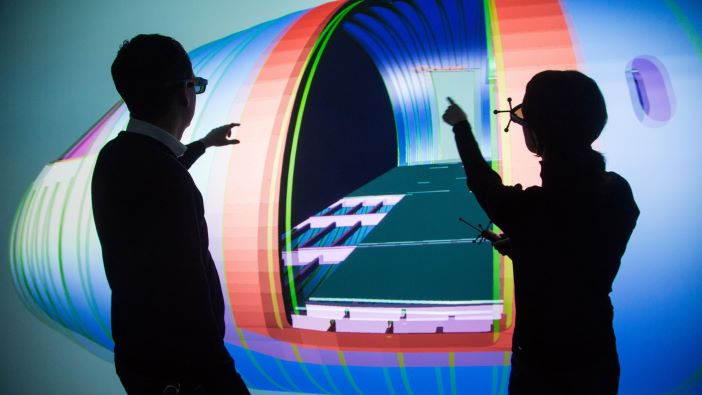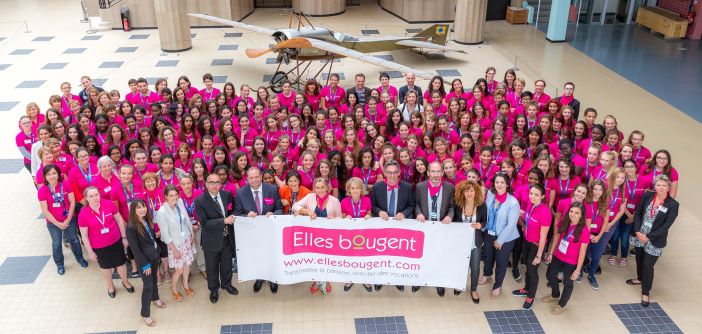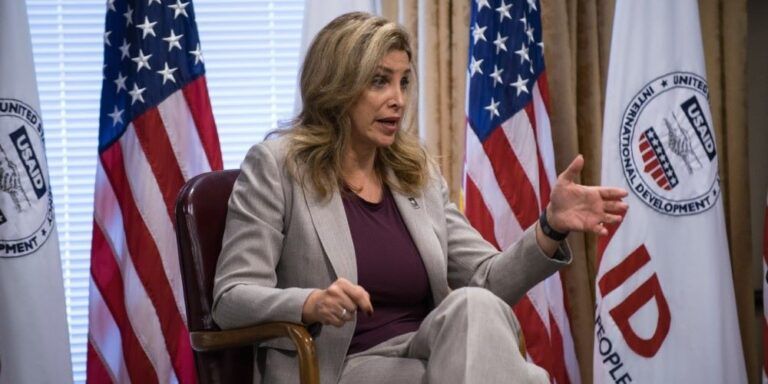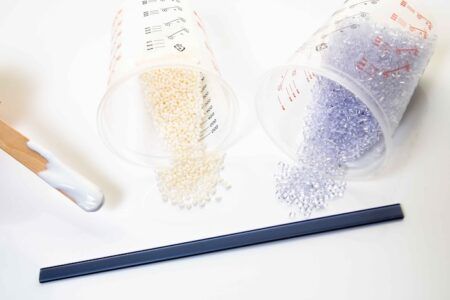Amanda Simpson, vice president for research and technology (R&T) at Airbus Americas, believes in having space to grow. She has a unique combination of experience that helps her recognise the potential in the simplest of innovations. She also possesses a unique enthusiasm for aerospace and an optimism for the future that is delightfully contagious. We spoke to her at length to hear her views on innovation and which developing aerospace technologies she’s most excited about.
“I define innovation as new ideas – hopefully good ones. Sometimes it’s about combining existing ideas in new and creative ways that create a new concept that no one has put together before. That’s how I define it,” she says.
“I’ve seen people come up with an idea and not recognise the value that it has because they don’t have the insight or the understanding of the greater impact that their concept has. It’s not only about how you recognise an idea, but how you mature an idea so that it becomes reality – that’s crucial. That’s what the job is all about. It is about recognising these ideas and implementing them. Infrequently am I the person who innovates – rather I make that innovation into reality or at least get it along that path.”
Simpson counsels innovators not just to share their concepts, but to share them with people who have the knowledge and expertise to appreciate their value in a particular field.
“It may be a better concept, but you need to find someone who is familiar with the market – and I use ‘market’ in a very broad sense –in the context that they can say, ‘this has already been tried’ or ‘that’s really novel and I can see how it has a benefit for consumers or for customers, or for others’,” Simpson says.
She also advises against being too protective of creations and not sharing them for fear that they will be stolen. “I’m quite positive that if someone did a thorough investigation through the archives of the patent office, they would probably come across many good ideas, real innovation that never went anywhere because people didn’t know how to share it and how to make it a reality,” she says.
The types of innovations that happen most often in aerospace, Simpson says, aren’t big and flashy. “Sometimes they are small and incremental, and incorporated in ways that few ever notice. This is happening all the time,” she says.

Simpson believes that some of the innovations that will shape aerospace in the future are not so much in products but in processes – facilitated by automation and virtual or augmented reality.
“I worked at Douglas Aircraft in Long Beach, California, in the early 1980s and, quite frankly, we are building aircraft pretty much the same way we did almost 40 years ago. So there is real opportunity to leverage automation and information for how we build and support aircraft,” she says.
“I think we’re going to start seeing more and more robots and automation on the [factory] floor, changing how we build aircraft and how we move equipment around. We’ve recently started to see it. When I was at Douglas, you’d see people on three-wheeled bicycles with large baskets, maybe even pulling a trailer with some more parts on it, all around the production floor. We’re going to start seeing more of that work handled by robots that navigate autonomously around the production floor.”
Information processing is also due for change, according to Simpson. “We are using computers to design aircraft much more accurately than we did in the past – when I started, it was paper and vellum – but when you get to the production floor, where they are actually putting together the airplane or installing the interior, they are pulling up drawings from a computer usually sitting outside the aircraft or drawings with work instructions that they have to refer to, and they are going back and forth.
“I think we’re going to start seeing opportunities with smart goggles or smart glasses whereby installers will actually be able to see the instructions in front of them while they are working on something. They’ll have a diagram or a picture of how things should be fitted, and they can then actually move the pieces and parts into that exact position. I think that is going to be really important when we get into maintenance, where they can see where things are supposed to be versus trying to refer back and forth to a computer screen or PDA, or even a piece of paper.”
This virtual way of imparting information, Simpson believes, will also be used in the training of mechanics, maintenance crews and pilots. Virtual and augmented reality tools will enhance training, reducing the length of apprenticeships and allowing trainees to start working sooner.
“I was recently in a facility, wearing 3D glasses, and it felt like we were standing in the aircraft,” she says. “You could walk around. You couldn’t touch anything because it wasn’t really there, but you could look into corners and could see right down into the parts and how they were assembled. There wasn’t an aircraft being built within 15-20 miles of where I was standing, but it was like I was there inside an aircraft. That ability to orient people to a work environment, to instructions, before having to tie up the actual hardware, is going to be a real game-changer.”
But aerospace innovations will not be limited to digital tools or robotics – some will be very tactile. “We’re seeing a lot of new materials coming into play that will impact interiors,” Simpson says. “They’re going to become lighter, stronger, they’re going to require less prefabrication prior to installation. There’s a really opportunity there. I know we are looking at that in great detail, because it’s one of the long-term items when you are trying to get an aircraft out onto the runway.”

Looking further into the future, 20 years out, Simpson believes that the electrification of aircraft and the automation of aircraft operations are the most likely paradigm shifts in aerospace.
“There is going to be a move, probably over the next decade, of moving away from turbofan jet engines to electric propulsion. It’s cleaner, it’s quieter, and I think the traveling public is going to insist on it. It will be, over time, more economical than carrying kerosene around,” Simpson says.
She acknowledges that there are still details that have to be worked out, such as the storage and distribution of electric power. But, she says, “Those things are being worked on right now, and once they are resolved, that’s going to have a huge impact.”
There will also be advances in automation of personal point-to-point transportation, including on-demand UAV (unmanned aerial vehicle) services. Electric propulsion and automation will help deliver these services. Simpson also believes that automation is coming to the flight deck. Despite pilots voicing concerns over research into single-pilot operations, Simpson believes it is both practically and economically inevitable.
“As things become more automated in the aircraft, there may not be a need for the redundancy of having two people [in the cockpit]. Keep in mind, we already have aircraft that are self-navigating – even more so than cars. Pilots today are much more like systems managers – they input the information and the computer runs the flight. They may be manipulating the throttle and handling communication, but all those things are going to start moving to computers in the near future. That’s going to be a huge shift as we move more and more into automation,” Simpson says.
“It’s going to come down to the economic issues, without compromising safety. The aerospace industry has an amazing safety record, and I don’t believe anyone is going to compromise that. But, at the same time, we have to understand that there are other ways to achieve that level of safety other than having probably one of the least efficient decision-making machines in the sky: the human psyche.”
A note on diverse thinking
Simpson is an important figure in aerospace, and indeed an important woman in aerospace. She credits Airbus for developing mentorship programmes designed to encourage underprivileged and minority students, including women, to explore careers ranging from defence to aviation, to aerospace. She also points out that Airbus has put women in charge in critical STEM roles including the current and previous chief technology officers and the chief engineer of single-aisle airplane production in Hamburg. She considers herself fortunate to have had a unique career and a range of opportunities in different sectors of aerospace, both civilian and military. Simpson says it has helped her identify opportunities for innovation that others might miss.
“Tying all of those little bits together, and being a generalist, is sometimes a very valuable asset,” she says. “I’ve spent almost 40 years becoming the best generalist I could. Because I have been a generalist and moved beyond the technical side of engineering, I learned how to talk to people, learned how to communicate with politicians, and learned how to develop and understand policy and regulations so that I am able to communicate at a high level and with detail, because of my technical background, which not many people have had. I encourage people to develop skills beyond their technical focus or the degree that they pursue at university,” she says. “I talk to people and share my ideas and my dreams and what I see the future as being, which inspires other people to put their faith and their trust in me. That’s what brought me here. That’s the game-changer that women bring to the workplace. That is a critical skill.”
Simpson sees great things ahead for humanity, if we only give opportunities a chance to develop.
“I am very optimistic about the future,” she says. “People want to be in the future that we envision. They don’t truly want to stay where they are. They want to be the Jetsons and explore the stars and be able to move around the planet freely. All of the things that the future holds and promises are inspiring. That’s what brings people into this industry. They want to build a future for themselves and for their children. That’s what keeps me going, and that’s what inspires a lot of people.”
Setting out

Simpson pursued a career in aerospace inspired by growing up as a child of the 1960s (born in March 1961), tracking the developing space programme. She believes that a sense of wonder is critical to inspiring the next generation of aerospace professionals, both men and women.
“I wasn’t going to Woodstock or anything like that; I was glued to the TV and the newspapers watching the build-up and our eventual success at our moonshot and the space programme. I don’t remember Mercury, but I do remember the Gemini missions and everything that went on with Apollo. Then, the build up to the space shuttle when I was in college. That excited me and I wanted to be part of that. Going into engineering and finding out how all of these things work, that all made sense to me. I said, ‘This what I need to do’. I can’t say that I had engineers or such in my family, but it was what intrigued me,” she recalls.
Inspiring women
Simpson believes that mentoring and creating opportunities are critical for a diverse workplace that incorporates many talents.
“To get people inspired – particularly women – you have to expose them to role models. Show them women who excel or are participating in the aerospace industry. I cannot tell you the number of women that I meet at different corporations, or at airlines and small companies, that are incredible experts and are making massive impact on the aviation industry. But no one hears about it.

“It’s so important for young girls to see that women are out there doing the job and participating. We could go back to the 1940s and Rosie the Riveter was able to pick up pretty much any job that the guys were doing. Today, we’ve lost some of that,” she says. “Girls need to see the ordinary engineer or the pilot. It doesn’t have to be the astronaut. Just the ordinary people who are making the difference and can tell their story.
“We have to encourage them. We have to mentor them. We have to give them those opportunities and promote them. But it’s not just on the women, it’s on the men. Men have to stand up and say, ‘Jane is just as good as John and I rely on her to make the decisions on the product’. It can’t just be women pushing women. It has to be men in the industry who will stand up and support women. We need more women in leadership roles that are visible so that girls don’t leave engineering when they are young, so that they don’t leave math and science in primary school, and that they realise that they can have a career and a family and be successful.”
About Amanda
Born in Chicago on 26th March, 1961, Amanda Simpson went on to receive a Bachelor of Science in Physics from Harvey Mudd College, California in 1983, then a Master of Science in Engineering from California State University, Northridge in 1988 on a Hughes Aircraft Fellowship, and then went on to gain an MBA from the University of Arizona in 2001 on a Raytheon Fellowship.
While an undergraduate, Simpson spent her summers working as a student engineer in the customer service organisation on the DC-8/DC-9/DC-10 electrical systems at the Douglas Aircraft facility in Long Beach, and on the AH-64 Apache Target Acquisition and Designation Sight/Pilot Night Vision Systems at Hughes Helicopter Company in Marina Del Rey.
In 1983 she was hired by Hughes Electron Dynamics Division in Torrance, CA as an engineer and programme manager, responsible for engineering and manufacturing of the Gridded Traveling Wave Tube and Continuous Wave Illuminator for the AWG-9/APG-71 radar systems.
She was not just interested in the academic side of aviation though. Simpson participated in the Bates Aeronautics Program while a student at Harvey Mudd College, earning a single-engine land private pilot’s licence in 1981, and as well as joining Hughes in 1983, in that year she also earned a commercial pilot’s licence with instrument privileges. Such was her skill, she became a certified airplane flight instructor in 1988 and an instrument instructor in 1989. She also added a multi-engine class rating to her commercial licence to qualify for transfer to Hughes Missile Systems as a project test engineer and pilot.
Simpson upgraded to an Airline Transport Pilot’s (ATP) licence in 1994 after adding multi-engine to her flight instructor ratings in 1991. In 1997 she added single-engine sea (float planes and flying boats) to her ATP licence. In 2005 she became one of only a few licenced pilots flying FAA-certified unmanned aircraft in the national airspace system.
In 1989 she co-founded Processional Pilot Training, a fixed based operation at Burbank, Glendale, Pasadena Airport (KBUR) focused on flight instruction (private through to airline transport) taught by professional flight instructors. She relinquished her ownership share of that business when she relocated to Tucson, Arizona in 1994.
Simpson became Hughes Missile Systems’ mission director and project pilot for captive flight test activities in 1988 before taking over as Director of Flight Operations in 1993 for the Integration, Test and Analysis Laboratory at Hughes Missile Systems (Simpson designed and oversaw construction of its 80,000 sq. ft. dedicated flight test facility). As a systems test pilot she flew the T-39 Sabreliner and Douglas A-3 Skywarrior in support of missile seeker technology development for Hughes Aircraft and Raytheon Missile Systems. In addition she flew numerous large transport category aircraft, light multi-engine and single engine aircraft modified for missile flight test purposes.
Simpson moved into project management in 1999, overseeing the daily operations of small Raytheon, Texas Instruments Defense Systems & Electronics Group, and Standard Missile Company projects that had been relocated to Tucson as part of the corporate merger.
Between 2002 and 2006, Simpson occupied several systems engineer, systems architect, and systems integrator roles at Raytheon, on projects including the Unmanned Combat Armed Rotorcraft (UCAR), the Joint Airborne Weapons System (JAWS; later renamed the Beechcraft AT-6B) and a variety of advanced technology development and demonstration projects. Simpson also contributed to the development and/or testing of numerous operation missile systems including Maverick, AMRAAM, Standard, Phalanx, TOW, RAM, JAGM, ACM, HARM, JSOW, MALD, ESSM, SilentEyes, Sidewinder, Sparrow, Paveway and Tomahawk.
As of 2009, she had flown over 60 different makes and models of aircraft and has accumulated over 2,700 flight hours.
She went on to become Raytheon’s deputy director and senior programme manager, leading teams developing advanced technology in the Advanced Missiles and Unmanned Systems product line. She left the company in 2010.
Completing her public service with the Defense Department, she joined Airbus Americas in 2018 as the Vice President for Research and Technology. In this role she is responsible for establishing the strategic direction and funding opportunities for partnerships with scientific and research communities in North America.
She has also served on the board of directors of the Commonwealth Center for Advanced Manufacturing, Advanced Thermal Batteries, Inc, and is chairperson of the Airbus Institute for Engineering Research at the University of Southern California.
In late 2022, Simpson was appointed by Transportation Secretary Buttigieg to serve on the Commercial Space Transportation Advisory Committee (COMSTAC) along with 20 other new members, to provide information, advice and recommendations to the FAA and DOT about technology, business and policy issues regarding oversight of the US commercial space transportation sector.
A political life too
Simpson’s aerospace career was packed with action and achievements, but she somehow found time for several other activities.
She served as a commissioner on the City of Tucson’s Gay, Lesbian, Bisexual and Transgender Commission from 2001 until 2008, representing Councilwoman Carol West. Simpson was a candidate for Representative of District 26 in the Arizona House of Representatives in 2004. She won the Democratic primary with over 57% of the vote, but was unsuccessful in the general election where she finished third, receiving 20% in the best two of four contest.
In the 2004 election, Simpson was elected precinct committeeperson, and was chosen as a state committeeperson by the Democratic Party of Legislative District 26 in 2006. She was also elected to the Executive Board and held the office of District Treasurer in 2008. At the Arizona Democratic State Convention in 2008, Simpson was elected as an Arizona Delegate for Hillary Clinton to the 2008 Democratic National Convention.
In late 2009, Simpson accepted an appointment by the Obama Administration, where she served in the Department of Commerce as the Senior Technical Adviser to the Bureau of Industry and Security. She was the first openly transgender woman US presidential appointee.
In July 2011, she was reposted to the Pentagon as the Special Assistance to the Assistant Secretary of the Army for Acquisition, Logistics and Technology (ASA/ALT). In July 2013, Simpson was detailed to the Army Energy Initiatives Task Force, where she served as the Deputy Executive Director until January 2014, when she was named the Executive Director by the Assistant Secretary of the Army for Installations, Energy & Environment (ASA-IEE). In October 2014, the Army Energy Initiatives Task Force became the US Army Office of Energy Initiatives (OEI).
In September 2015, Simpson was sworn in as the first Deputy Assistant Secretary of Defense for Operational Energy [DASD(OE)], a position she served until the end of the Obama administration as she was asked to resign along with nearly all appointees. She departed the Pentagon on 19th January, 2017.
And there’s more
Simpson has also been involved in much non-profit work, serving on the boards of the Wingspan Community Center, the Southern Arizona Gender Alliance, the Arizona Human Rights Fund, the National Center for Transgender Equality, Out and Equal Workplace Advocates, and the Southern Arizona Chapter of the American Civil Liberties Union.
While an employee at Raytheon, she served on the boards of the Raytheon Women’s Network; Raytheon Global Women’s Network; the Gay, Lesbian, Bisexual, Transgender and Allies Alliance; and the Raytheon Diversity Council.
Simpson is an Associate Fellow with the American Institute of Aeronautics and Astronautics and served on its Systems Engineering Technical Committee from 2007 to 2009.





